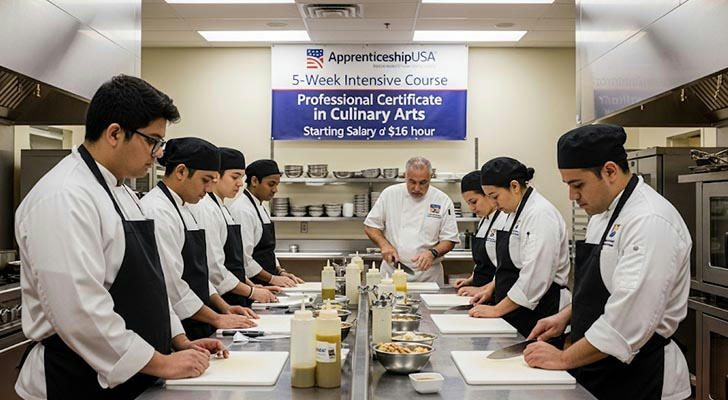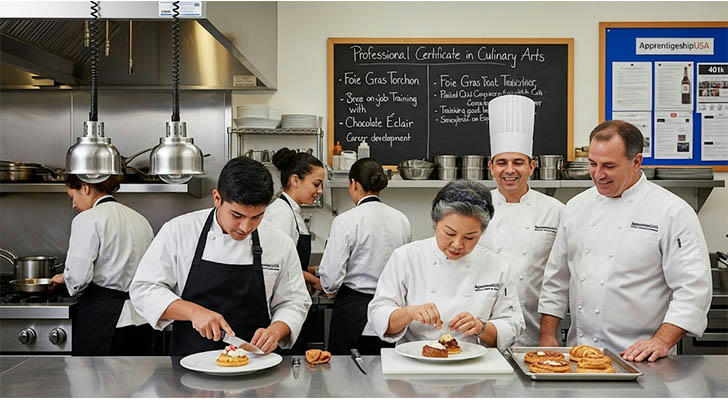How to Join a Government-Supported Culinary Arts Training Program (Full Guide)
Gain industry-recognized culinary qualifications and career opportunities
Want to become a professional chef but don’t want to pay high tuition fees? You don’t have to worry about the cost of culinary arts programs funded by the US government, such as ApprenticeshipUSA. Upon completion of the program, students will receive a culinary certificate, employment assistance, and a state-issued study permit to start a successful culinary career.

What Are These Programs?
These programs are designed to make professional culinary training more accessible through government-backed funding and employer partnerships. They offer structured, hands-on instruction combined with real-world kitchen experience—ideal for individuals looking to enter the culinary industry quickly and affordably.
Key Providers
- ApprenticeshipUSA: This program initiated by the U.S. Department of Labor works with employers to provide structured, paid, on-the-job culinary training. Under the guidance of experienced chefs, you will not only receive wages (starting at $16 per hour), but also enjoy a variety of benefits: 401k plan, company benefits, career development opportunities, promotion plans, scholarships, etc.! And improve your skills.
- Professional Certificate in the Culinary Arts, you will master comprehensive skills from gourmet cooking to French dessert making: professional knife skills, basic and advanced cooking techniques, flavor construction, meat and seafood processing, to the exquisite creation of bread, pastry and chocolate. The course totals 192 hours and provides flexible course selection - you can choose a 5-week crash course, a 10-week full-time course or a 4-month part-time mode to suit different time arrangements. In addition, the course is accredited by the American Culinary Federation (ACF) and meets the chef industry standards.
What You’ll Learn
During the course, participants will develop a solid foundation in:
- Culinary techniques (e.g., knife skills, sautéing, baking)
- Food safety and sanitation
- Plating and presentation
- Kitchen operations and team collaboration
Many programs include externships or real kitchen placements, preparing students for fast-paced work environments.
Paid Training
Participants benefit from financial support such as stipends or hourly wages during training. This allows individuals to build experience and income at the same time, easing the financial burden often associated with vocational education.
Certifications and Benefits
Upon completing the program, graduates typically receive:
- An industry-recognized culinary certificate
- A state-issued learner’s permit
- Career support services , including resume building and job placement assistance
These credentials significantly enhance employability and pave the way for long-term career growth.

Career Paths by Age Group
| Age Group | Suitable Roles | Career Development Paths |
|---|---|---|
| 16–24 | Prep cook, kitchen assistant, café staff | Sous-chef, chef de partie, further culinary education |
| 25–40 | Line cook, catering staff, food truck operator | Shift supervisor, restaurant management, entrepreneurship |
| 40-55 | Institutional cook, kitchen team lead, small business | Team leader, catering manager, mentor |
| 55+ | Bakery staff, instructor assistant, community kitchens | Part-time roles, mentoring, flexible food-related work |
Career Opportunities After Graduation
Graduates are qualified to work in a wide range of culinary and hospitality settings, including:
- Restaurants and cafés
- Hotels and resorts
- Catering companies
- Cruise ships
- Institutional kitchens (such as schools, hospitals, and corporate cafeterias)
With experience, many go on to become sous-chefs, executive chefs, food service managers—or even start their own food-related businesses.
How to Apply
Getting started is easy. Follow these quick steps:
- Pick a Program: Choose from ApprenticeshipUSA, Professional Certificate in the Culinary Arts.
- Visit the Website: Go to their official site and find the application section.
- Check Requirements: Most programs require you to be 16+, legally able to work in the U.S., and able to work on your feet.
- Apply Online: Fill out a short form with your ID and background info.
- Start Training: Once accepted, you'll get a start date and course details.
